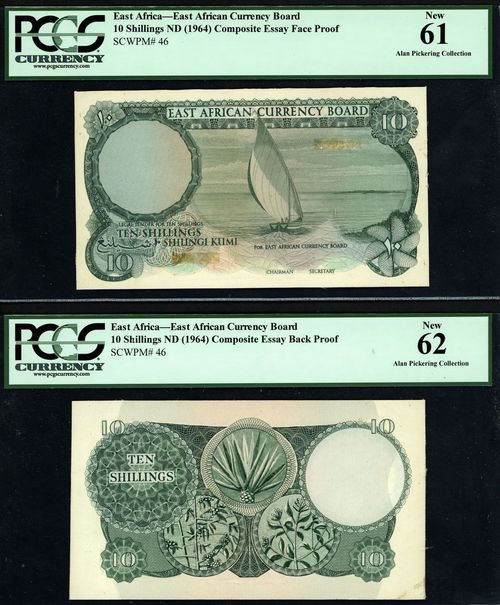Auction: 391 - World Banknotes at NY INC
Lot: 86
East African Currency Board, a uniface obverse and reverse hand executed essay for 10 Shillings, no date (series of 1964),
established in 1919, the East African Currency Board was tasked with overseeing and providing currency for the British colonies in British East Africa. This responsibility arose after Britain acquired mainland Tanzania from Germany at the close of World War I. Initially managing Uganda, Kenya, and Tanzania (excluding Zanzibar), the board's jurisdiction expanded to include Zanzibar in 1936. The East African Shilling, under the board's administration, was adopted in parts of Somalia, Ethiopia, and Eritrea during British wartime control from 1941 to 1965. Additionally, it was used in the Aden colony and protectorate from 1951 to 1965.
Operating from 4 Millbank, London SW1, formerly the offices of the Crown Agents, the East African Currency Board played a pivotal role. Its primary function was to issue and maintain the value of the East African Shilling at par with the British shilling, ensuring ample backing by sterling securities.
Throughout its operations, the board produced several essays, including unique hand-executed designs for 10 Shilling banknotes. This note is an example from an unreleased 1964 series which predominantly features the colour green. On the obverse side, a small sailboat on Lake Victoria is set against a backdrop of rocks, while the reverse side showcases the national arms near the lower border, accompanied by depictions of a coffee plant with berries and other flowers. These distinctive, unadopted artistic endeavours set these designs apart from any issued notes.
As East African territories gained independence (Tanganyika in 1961, Kenya in 1963, and Uganda in 1962), the East African Currency Board was dissolved in 1965, marking the conclusion of the East African Shilling era. Each independent nation subsequently introduced its own currency.
In 1967, the East African Currency Board was succeeded by the independent central banks of the constituent countries: Bank of Uganda, Central Bank of Kenya, and Bank of Tanzania. This transition symbolised the shifting dynamics of the region as these nations gained independence and assumed control over their monetary policies
(Pick 46 for type), both in PCGS holders 61 New and 62 New, ex Alan Pickering collection, unique (2 notes)
Estimate
£520 to £750
Starting price
£520







